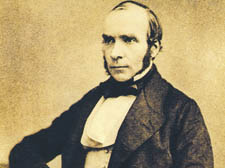|
|
 |
| |

John Snow (1813-1858) was a doctor who virtually single- handedly ended the cholera scourge of 1849 |
The John Snow who made his own headlines
The man who ended a deadly cholera outbreak is among the medical heroes examined in a new book by north London GP Naomi Craft, writes Peter Gruner
THE LITTLE BOOK OF MEDICAL BREAKTHROUGHS
By Dr Naomi Craft. New Holland £7.99.
HE'S one of history’s great heroic figures. But mention his name in our age of celebrity and many will think you’re talking about the Channel 4 news presenter.
In fact John Snow (1813-1858) was a doctor who virtually single- handedly ended the cholera scourge that killed more than 50,000 people in England in 1849.
In a new book, St John’s Wood GP and writer Dr Naomi Craft reveals the extraordinary story of how Snow linked the outbreak with contaminated water in Soho, and, by removing a pump handle, closed off the source of the disease.
In The Little Book of Medical Breakthroughs, Dr Craft charts the remarkable stories behind the unsung heroes of more than 100 discoveries and inventions that have improved people’s lives. This is both an inspiring read, and a must for the pub quiz enthusiast.
Dr Craft reveals how we got everything from the humble aspirin and condom, to the contraceptive pill, a pair of reading spectacles,
X-rays, general anaesthetics, and artificial limbs, including hip replacements.
This the second book by Dr Craft, who lives in Tufnell Park. Her first was the popular Children’s Encyclopaedia of the Human Body.
“The Little Book was inspired by a competition run by the British Medical Journal,” says Dr Craft. “It was to find the most significant medical breakthrough of all time.
“BMJ readers decided it was the story of John Snow, the GP who took the pump handle off during a cholera outbreak. He realised that there were all these cases of the disease but no one knew what caused it.
“He plotted cases on a map and discovered that all the people who were getting ill were coming to this water pump. Of course, nobody believed him. So he took the handle off and suddenly all the cases stopped. It’s considered to be one of the biggest public health breakthroughs in the history of medicine.”
Another extract in the book deals with reading glasses. We all take them for granted, but there is no clear evidence who invented them and when. Certainly they were in use by the end of the 13th century.
Dr Craft writes: “One Roman philosopher claims to have read ‘all the books of Rome’ by looking through a glass bowl filled with water, which would have acted as a primitive lens.”
Before the 1840s and the discovery of general anaesthetics, patients endured unimaginable agony during surgery. For centuries doctors had used opium and alcohol to reduce pain. It was New York chemist and doctor William E Clarke’s (1818-1878) introduction of pain-killing ether for teeth extraction that inspired the widespread use of the product. This was later replaced by chloroform with fewer side-effects.
Dr Craft writes that it is virtually impossible to imagine treating a blister or small cut these days without being able to reach for an adhesive plaster. American cotton buyer Earle Dickson (1892-1961) was concerned that his wife Josephine kept cutting herself while preparing food and all he could apply was a clumsy dressing.
He went to work and folded sterile gauze in the centre of a strip of surgical tape and then covered that with a piece of crinoline to prevent the tape from sticking to itself. Dickson finally persuaded his company to make his design commercially and they called it Band Aid. The rest is history.
Condoms have been around since ancient Greek times, although not in their present form. The Greeks used linen ones which, although unreliable, were perhaps more appealing than the tortoiseshell creations that the Japanese favoured, or the leather, animal gut or fish bladder condoms used at different times around the world.
In 1843 rubber vulcanisation, invented by Charles Goodyear (1800-1860) and Thomas Hancock (1823-1871), made it possible to produce cheaper, more reliable condoms that were stretchier and easier to use.
However, men were still encouraged to wash and reuse them. It was the development of latex in the 1930s that led to the creation of the cheap throwaway condoms of today.
•
 |
 |
|
 |
 |
|
 |
|



